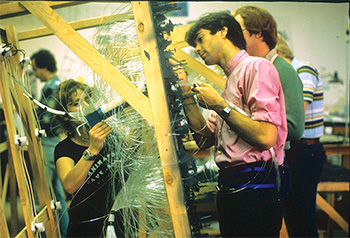Tip #1347: The Miniature Models of Blade Runner
… for Visual Effects
Tip #1347: The Miniature Models of Blade Runner
Larry Jordan – LarryJordan.com
Effects created from practical effects, miniatures, optical compositing and real 65mm film.


This article, written by Ian Failes, first appeared in VFXVoice.com. This is a summary.
In 1982, Ridley Scott’s Blade Runner set a distinctive tone for the look and feel of many sci-fi future film noirs to come, taking advantage of stylized production design, art direction and visual effects work.
On the eve of the release of Denis Villeneuve’s Blade Runner 2049 sequel, VFX Voice revisits the miniatures of the original film with chief model maker Mark Stetson, VES. He and a crew of distinguished artists helped to craft many of the film’s iconic settings and vehicles, including the opening Hades landscape,
Blade Runner begins with a slow push-in over a heavily industrialized section of Los Angeles. Many were surprised when it became apparent that the endless refinery imagery – known as the Hades landscape – was largely achieved with rows of acid-etched brass silhouette cut-outs in a forced perspective layout.
The ground plane structures were painted quite roughly to make the buildings look ‘aged and crappy’ – instant coffee was even used for that effect. Then, after making an evening flight into Los Angeles, Stetson was inspired to replicate in the Hades landscape the look of thousands of city lights.
A myriad of fiber optic strands – seven miles worth – was added underneath the tables holding the silhouettes and other model pieces. The lights included a mix of different bulbs, too, all filmed in different passes, as were the gas flares captured ‘in-model’ with specially placed projection screens and a synchronized 35mm film projector.
Equally iconic in Blade Runner lore are the flying police vehicles known as Spinners. In visual futurist Syd Mead’s design explora- tions for Blade Runner, he called the flying vehicles ‘aerodynes.’
The vehicles were particularly recognizable for their flaring and spinning police lights. In fact, the larger scale Spinner models were a significant feat of engineering. They were made to include room for cabling, stepper motors, lighting, and even nitrogen plumbing for exhaust.
“Late in the development of the models, Ridley asked for a rack of gumball-style police lights to be mounted on top of the car,” says Stetson. “Getting the lights to spin on the model required a new lighting rig that replaced the rear bodywork on the model and was shot on a repeat pass using motion control. We made little brass cans for each halogen light, with lensed snoots driven through speedo cables by a rack of stepper motors on the back of the car.
This article goes into a lot more detail with excellent production stills of models and sets in construction.


Great fun! thanks for a bit of a veer off the usual (also-great) tips, down memory lane and behind the scenes of an Iconic film!!
Stu